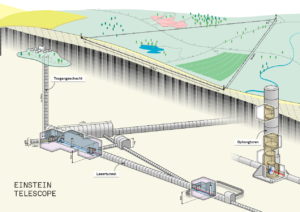Supported by the Netherlands, Belgium, Poland and Spain, the Italian government submitted an application on Wednesday to include the Einstein Telescope in a European roadmap for major research infrastructures. The inclusion of the Einstein Telescope in this ESFRI roadmap will be a recognition of the importance of the Einstein Telescope for Europe.
According to advanced plans, the Einstein Telescope will be the largest ever observatory for observing gravitational waves coming from colliding stars and black holes in the Universe. Such observations offer a new window on the cosmos and its history.

Scientists from 41 research institutes in 10 countries prepared the application together. Wednesday September 9th it was submitted. Although Italy submitted the proposal, this does not mean that the infrastructure will be in Italy. There are currently two possible locations: Sardinia and the border area of Belgium, Germany and the Netherlands (Euregio Meuse-Rhine). Both possible locations are included in the application.
The ESFRI roadmap will be launched in October or November 2021. When the Einstein Telescope receives the ESFRI status, the authorities will decide whether to apply to host the infrastructure. This will probably happen around 2023. The decision on the location falls within five years.
Important milestone
Nikhef Director Prof. Stan Bentvelsen is pleased with the progress: “The Einstein Telescope guarantees a long future of fascinating research. This instrument detects gravitational waves with unprecedented precision and gives us a spectacular new view of our universe. Within the Nikhef strategy, the Einstein Telescope is one of the spearheads. I am proud that this broad consortium managed to submit the ESFRI application today. If this observatory is allowed to land in the Meuse-Rhine Euroregion, we will gain the world’s top scientific infrastructure”.
Prof. Andreas Freise is working on the technical design of the Einstein Telescope and is pleased. “The ESFRI submission marks the moment when we formalize the enthusiasm and support of others for our project. The political support of five European governments, for example, and the great interest of the regions where the Einstein Telescope could come”.
Professor Frank Linde confirms: “This is an important milestone for the Einstein Telescope consortium. And he explains the next steps: “My colleagues and I continue to work hard to embed the Einstein Telescope in the Meuse-Rhine Euroregion. We are also making contact with potential partners in the industry in order to develop the most challenging technological innovations together. And hopefully we will then present a sublime bid book to host the Einstein Telescope in 2024”.
A new window on the universe
Researchers detected gravity waves for the first time in 2015. This discovery with detectors in the US and Italy offered a completely new way to study the universe and opened up a new field of research in physics and astronomy. The Einstein Telescope becomes much more sensitive than the existing gravity wave detectors. As a result, the observatory allows scientists to look into the dark ages of the Universe for the first time, until just after the Big Bang.
The Einstein Telescope is a future gravity wave observatory. The detector is designed as a triangle of long tunnels, each 10 km long. The instrument will be underground 200-300m.
Preparations in Belgium, Germany and the Netherlands
Many research institutes, governments and companies in Belgium, Germany and the Netherlands are already involved. They investigate the subsurface, work on the technological challenges and investigate the economic impact. A study from 2019 shows that the subsurface of the Meuse-Rhine Euroregion seems ‘quiet enough’ for the Einstein Telescope. The observatory can also have a significant economic impact on the Euregio.
There is also a great deal of interest from industry to cooperate. More than fifty different companies recently attended webinars on technological challenges. Further geological studies, technological innovations and other preparations are ongoing. Part of these activities falls under the projects ETpathfinder and E-TEST. Currently, a project is also being prepared to further support the cooperation between science and industry.